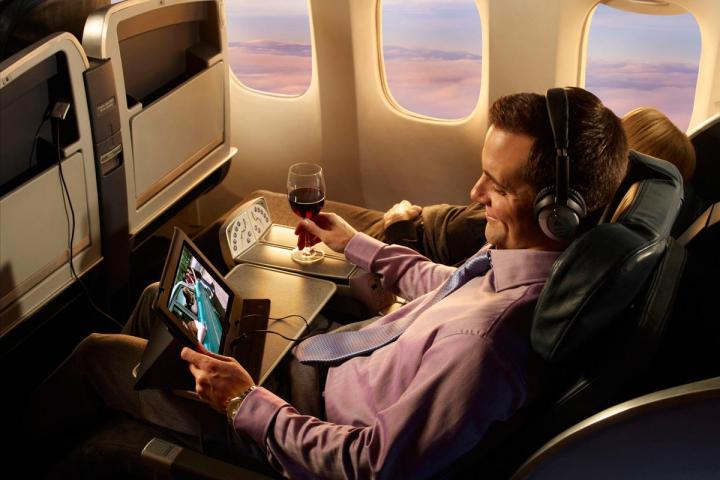
Domestically, Internet is typically provided through air-to-ground (ATG) technology. Gogo’s ATG service, the dominant provider, is based on a cellular radio network, meaning it relies on land-based towers. That also means the plane will possibly experience dead spots in connectivity as it moves from one service area to another, or over large bodies of water. The maximum download bandwidth of the first-generation technology is only 3.1Mbps, although the company’s newer ATG-4 service supports up to 9.8Mbps. Virgin America, one of the more tech-savvy airlines, was the first to roll out ATG-4 across its fleet.
Related Offer: Thousands of movies and TV shows on Amazon Video. Try it free for 30-days.
Despite being three-times faster than its predecessor, ATG-4 isn’t fast enough to handle high-bandwidth applications, like streaming services (YouTube, Hulu, Netflix, etc.). That’s why airlines are looking to satellite-based technologies, which aren’t only faster but allows for worldwide, uninterrupted service. While satellite-based Wi-Fi isn’t new, the availability had been limited to a handful of international flights. But as passengers are now increasingly more mobile and consuming content from their phones and tablets, satellite-based services are able to deliver the speed and bandwidth needed, regardless of route. And, an enhanced network allows airlines to implement new communications technologies, such as wireless streaming to passengers’ devices in lieu of seatback systems.
Virgin America and Gogo had originally planned to install Ground to Orbit (GTO), a hybrid system that features a satellite antenna (Ku-band) mounted on the plane for downloads and the ATG-4 antenna for the uploads, promising maximum speeds of 60Mbps. Gogo is also working on a platform called 2Ku that uses two Ku-band (2Ku) satellite antennas for uploading and downloading at a max speed of 70Mbps; it’s robust enough to stream both Netflix and Spotify simultaneously.
Although industry watchers had thought Virgin America would skip GTO and opt for 2Ku, Virgin America is installing an even faster system from ViaSat (however, with Alaska Airlines’ acquisition of Virgin, it remains to be seen what Alaska plans to do in terms of in-flight Wi-Fi).
ViaSat, which brands the service as Exede, announced in February the upcoming launch of two Ka-band-based high-capacity satellites, ViaSat-2 and ViaSat-3, that are expected to improve speeds and expand the broadband service footprint across North America, Central America, the Caribbean, and more.
According to ViaSat, the ViaSat-3 is a platform of three satellites and a ground network infrastructure. Each satellite will provide more than 1Tbps of bandwidth for high-speed Internet across “multiple applications simultaneously.” The first ViaSat-3 system will point at the Americas while a second system will focus on Europe, the Middle East, and Africa. A third system is planned for the Asia-Pacific region, the company said. Besides Virgin America, JetBlue and United Airlines use ViaSat, while American Airlines is considering it as well, according to analysts.
Inmarsat is another player that provides in-flight broadband. According to Reuters, this company has worked on its Global Xpress network over the last five years. The company’s I-5 F2 satellite already provides broadband connectivity to the Americas and the Atlantic Ocean region, while the I-5 F3 covers the Pacific Ocean region and the I-5 F1 covers Europe, the Middle East, Africa, and Asia. The service was introduced commercially back in December 2015, and Lufthansa and Singapore Airlines are two carriers that have signed up.
“GX Aviation will globally deliver the fastest broadband in the skies. And because we own and manage the entire network, service levels will be consistently high, wherever you fly,” Inmarsat said. “It expands the possibilities for in-flight entertainment to real-time TV and TV on demand as well as standard email and web browsing at a much faster speed.”
Presently, only 6 percent of the flights that offer Wi-Fi have speeds that are comparable to broadband that’s offered in the home, according to a report provided by Routehappy. More than 1/3 of all available airline seats worldwide offer in-plane Internet connectivity, with Delta, United Airlines, and American Airlines offering the most seats with in-flight Wi-Fi in the United States, while Virgin America claims it’s the only carrier to offer Wi-Fi across its fleet.
David Bruner, vice president of global communications services at Panasonic Avionics, told Reuters that the next 24 months will be “really crazy” because companies offering satellite broadband will be fighting for contracts. Panasonic Avionics is also looking to get a piece of the in-flight broadband pie. However, Bruner said that there are currently “too many players fighting over too few planes.”
Ultimately, this “hyper-competitive” market may be a price war for these companies, but for consumers, it means they will finally be able to stream video from the likes of Netflix and Hulu, and skip the in-flight movie that will likely bore them to sleep anyway. Of course, the popularity of this in-flight connectivity option will depend on the final end-user cost. Virgin America, which had been beta testing the ViaSat service since July 2015, recently announced pricing, starting at $5 for a short-haul flight of less than two hours, and as much as $18 for a coast-to-coast flight for more than five hours. United charges $16 for non-Gogo flights. These prices should give an idea of what we can expect to pay as more airlines roll out satellite-based broadband.


